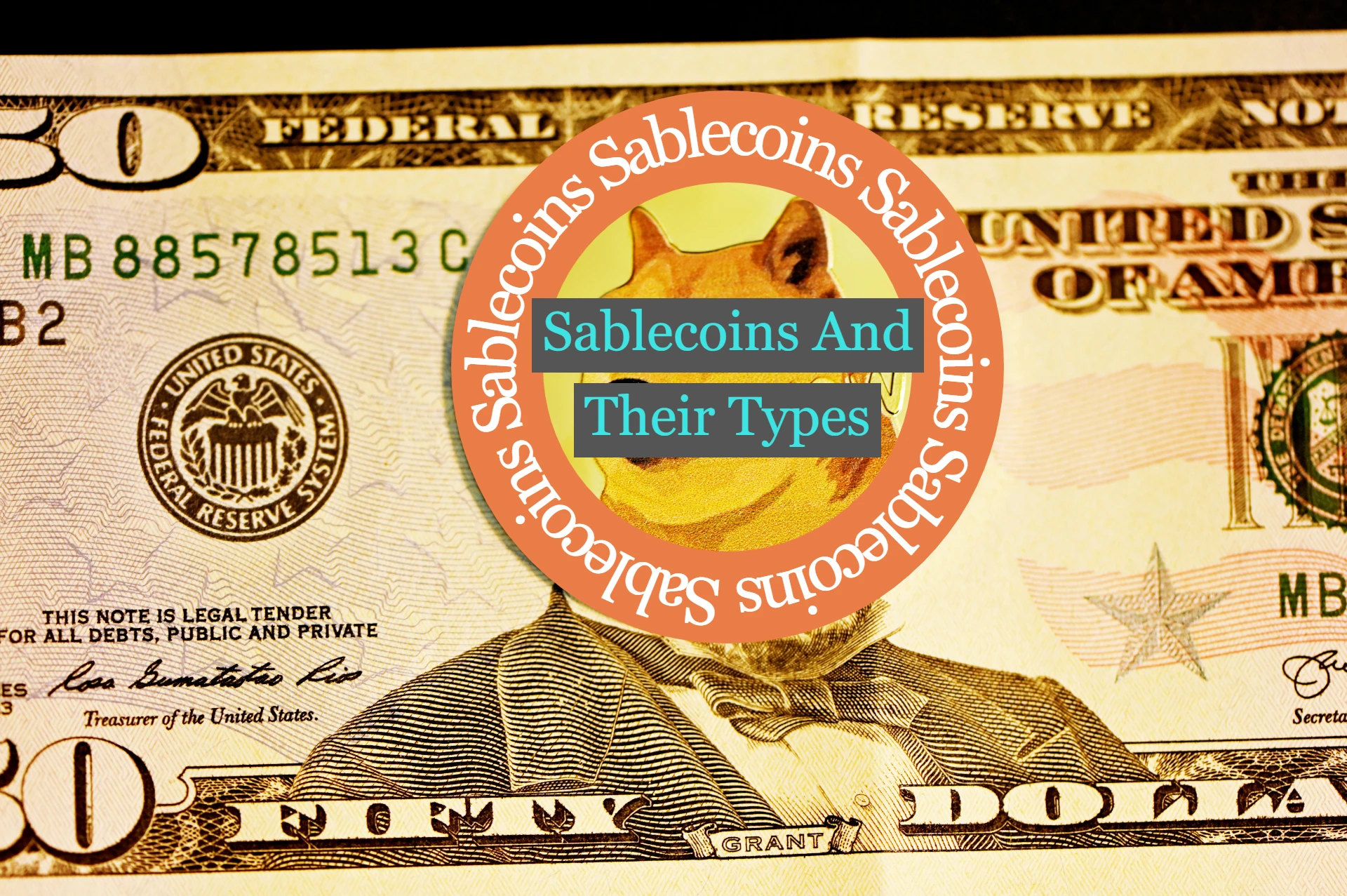This article aims to explain what are stablecoins and their types. With the continued development of Cryptocurrency, it has become more volatile than ever before. But investing in stable coins might be your answer to making your money safe while still investing in it on the global scale that cryptocurrencies have. Stable coins are quickly becoming the rave in the financial sector. Miners and users alike want to know what stable coins they can invest in and how they can get involved as well. The most stable coins come out of the various fiat to crypto exchanges, but there are some independent coins you can get involved with. So let’s look at what stable coins are right now and their types.
Table of Contents
What are stablecoins?
A stablecoin is a cryptocurrency with a fixed price, and it can be pegged to fiat currency, gold, or some other store of value. These are typically used for trading purposes in volatile markets, and these are characterized by their stability in contrast to the volatility of bitcoin and other cryptocurrencies.
A stablecoin is a cryptocurrency that has a fixed price. A stablecoin will usually be pegged to a relatively stable currency, like the U.S. dollar or Euro. One of the most popular stablecoins is called Tether. Stablecoins are cryptocurrencies that are designed to maintain a fixed price. They do this by having an algorithm-driven system of trading tokens with other cryptocurrencies, making the tokens scarce and valuable. The most popular use for stablecoins is a hedge against volatility in the crypto market. Cryptocurrencies can be highly volatile, so a token that has a fixed price is attractive to many investors.
Also read: 10 Top DeFi Coins to Watch in 2022
How do stablecoins works?
A stablecoin is a cryptocurrency pegged to a stable value, most often the U.S. dollar. They are most popular in developing markets with strict restrictions on capital flow and countries with hyperinflation. The idea is that a token’s price is predictable and won’t fluctuate wildly, unlike a more volatile coin like bitcoin. Why should you try to get one?
Well, first of all, there is no need to worry about the price moving with these tokens. Second, they are easy to use and transferable. You won’t have any problems if you have a token that is pegged to the dollar. There are no hassles in using these tokens. Also, it is easier to transfer them than fiat money or bitcoin. You can use these tokens in markets where it is difficult to use other cryptocurrencies. There are some websites where you can use a token to make payments. These tokens are also very easy to store, and you can easily buy and hold these tokens.
Types of Stablecoins
Many coins are “stable” because the market values are not constantly changing, making them a safer investment. However, there are variations in how these coins are designed to keep their value stable – some peg their price to an external asset like gold, while others use algorithms to ensure they stay at a certain price level. Read on for the differences between these types of coins and which ones might be better suited to your investing needs! Pegged-to-an-Asset Coins
These coins use a fixed amount of an external asset (like gold or silver) to stabilize their prices. The values are usually calculated using an algorithm, which is why it’s possible to have many different types of these coins in circulation at the same time. Examples include: BitGold uses a fixed amount of gold (1/100 ounce) to calculate its currency, uses a fixed amount of silver (1/1,000 ounce) to calculate its money, uses a fixed amount of precious metals (1/100 ounce) to calculate its currency Pegged to Fiat Coins. Pegged-to-fiat coins are pegged to their national currencies, like the U.S. Dollar. These coins are subject to the same monetary policies as paper currencies and can invest. Examples include: The Tether token is pegged to the U.S. Dollars, a token that the U.S. Dollar backs, so it’s a good option for investing in fiat currency or stable coin rather than invest in Bitcoin and Ether, which is highly volatile and have high risk in investment.
Collateralized Stablecoins
There are different forms of Stablecoins currently being developed. One type of Stablecoin is collateralized, where traders can lock up some form of the asset as collateral for their Stablecoin, just like how you lock up funds in your bank account for deposit purposes. This model gives traders confidence that the Stablecoins will remain stable because their value is derived from the underlying asset rather than some form of metric design.
Stablecoins are cryptocurrencies pegged to something with low volatility, like cash or gold. One of the early stablecoins was Tether, which maintained a value of USD 1 per token. The problem is that there is no way for an outsider to verify that the U.S. dollar backs these coins. Collateralized Stablecoins offer a more transparent option based on agreements between the issuer and collateral holder. Best of all, Coins can also redeem at any time for their intrinsic worth in whatever is being used as collateral.
Fiat-Collateralized Stablecoins
Fiat-collateralized stablecoins are a form of Cryptocurrency that requires users to pledge a conventional, legally defined currency to provide liquidity. For example, 1 US$ is exchanged for 1 USDT. There is market slippage for fiat-backed transactions, but these stablecoins can instantly convert these coins back into fiat by returning the tokens to the issuing party.
Fiat-collateralized stablecoins are derivatives that derive their value from an underlying fiat currency price. They are often pegged to a fiat currency based on established conversion rates with reserves held in escrow by a third party, preventing over-collateralization. This strategy increases the stability of decentralized Cryptocurrency, bringing peace of mind for users and merchants.
Fiat-Collateralized stablecoins are cryptocurrencies that are pegged to fiat currency. These digital currencies are precious because they have low volatility – meaning they can’t fluctuate too much due to price fluctuations. The advantage of this type of currency is the ease of exchanging it for both traditional and digital currencies. Fiat-collateralized stablecoins use straightforward lending and borrowing where the loan collateral is the currency itself (rather than physical assets).
Crypto-Collateralized Stablecoins
Crypto-collateralized stablecoins are a new type of crypto asset that aims to reduce the volatility in crypto markets. They have a fixed price and are backed by an equivalent amount of another cryptocurrency or backed by a certain ratio with another cryptocurrency.
Crypto-collateralized stablecoins are cost-effective, have built-in demand for their underlying collateral token, are deflationary by design, improve the efficiency of transferring value on blockchains, and provide a more attractive gateway to cryptocurrencies for institutional investors.
A new and profound use case is to create a crypto-collateralized stablecoin: a digital token that remains anchored at a fixed value relative to some other asset. Ideally, such tokens would allow you to trade or transact in any amount of money without having to worry about the fluctuations in its price.
Commodity-Collateralized Stablecoins
Commodity-Collateralized Stablecoins is backed with physical assets like real estate, oil, and precious metals. The most common commodities that can be collateralized are gold and silver. The collateral for these tokens usually consists of an internationally traded commodity. This means that each token is backed by a certain amount of notional value stored in the coin. A token distributed proactively offers trade execution and risk management services to deliver a safer and more stable tokenized version of the commodity.
A cryptocurrency tied to the value of an asset is often more stable than other cryptocurrencies because it can more accurately track changes in another asset’s value. This also makes them less volatile than fiat currencies, which depend on how governments change interest rates. Commodity-backed stablecoins work just like some traditional dollars, Euros, or Rand, where some paper dollars are tied to gold reserves.
Commodity-collateralized stablecoins or commodity-backed stablecoins work in a similar way to traditional Cryptocurrencies. The only difference is that the collateralized value will be the value of a commodity. In tokenized worlds, it’s easier for blockchain technology companies to create gold-backed tokens, allowing traders to use something they already want or own.
Also Read: Top 24 Metaverse Coins To Invest In For 2022
Algorithmic Stablecoins (Non-Collateralized)
Algorithmic Stablecoins is an exciting concept in the realm of cryptocurrencies, and they are not backed by any collateral but are still able to stay stable in value. This way, they are more appealing to people who need a less volatile currency, but they also have more risk.
Algorithmic stablecoins are decentralized, using algorithms that maintain the right balance between supply and demand without human intervention or reliance on external data sources. non-collateralized stablecoins use no external assets for backing – they function on pure supply and demand dynamics. Algorithmic Stablecoins are an essential part of the cryptocurrency ecosystem. They are designed to maintain a stable net asset value with minimal volatility against other cryptocurrencies or fiat.
Algorithmic stablecoins are a digital currency that is pegged to an underlying asset. non-collateralized stablecoins are algorithmic stablecoin that can be more resilient to getting hacked or manipulated. This is because they do not depend on the security of a centralized entity to keep its value.
FAQs Related to Stablecoins
What are stablecoins used for?
Ans: Cryptocurrencies, like Bitcoin, are notoriously volatile. One minute you could be up 10%, and the next, you could be down 20%. Stablecoins are designed to be less volatile because their value is pegged to fiat currencies like the U.S. Dollar or commodities like gold or sometimes with other cryptocurrencies. This means that stablecoins typically have a much lower risk profile than other cryptocurrencies, making them ideal for anyone looking to invest in them.
A stablecoin is a cryptocurrency coin with a fixed value, which means its price does not change. This is achieved by issuing the currency, creating more coins on the market, or withdrawing coins when needed to maintain their value. Many investors have been drawn to stablecoins because of their stability and reliability in uncertain times of crypto market volatility.
How do stablecoins make money?
Ans: Stablecoins make money by producing coins from an underlying, low-risk asset. Their value is index-linked to the price of this asset, and all coins are collateralized using a Credit Redemption Agreement contract. In other words, these coins are secured by something involving a loan repayment agreement.
In theory, stablecoins “make money” by using a return tied to some underlying asset. One example of this would be pegging a stablecoin to fiat currency and then guaranteeing investors an inevitable percentage return if the coin price was too high for a certain amount of time. The market maker has an incentive to stabilize the coin because they can maintain some revenue from providing their service.
Why invest in stablecoins?
Ans: The volatility of traditional cryptocurrencies like Bitcoin and Ethereum makes them impractical for everyday transactions and limits their use for speculative investments. The usefulness and safety are typically proportional to its stability; while volatile currencies can make money, volatile crypto cannot use them to purchase products. Investing in stablecoins will allow you to capitalize on the benefits of cryptocurrencies while minimizing any risk. We can convert heavyweight coins such as Tether into fiat currency, such that if the coin value drops during trading, assets are theoretically protected. More nimble coins such as Nano give investors more control over their assets by handling transactions directly, making them less vulnerable to outside manipulation.
Since the value of these cryptocurrencies is not based on an underlying asset, they are subject to volatility risk. This means that they are susceptible to wide fluctuations in price. A stablecoin is pegged to a physical good or known commodity set by a small variability. For this reason, they are consequently less risky investments than most other altcoins.
What is the purpose of stablecoins?
Ans: The purpose of a stablecoin is to get institutional users involved in Cryptocurrency by facilitating transfers from fiat to crypto and vice versa. Some people think that this design will make investment functions easier. In contrast, others believe that it will help stabilize cryptocurrency prices because, theoretically, there should always be a demand for coins.
How many types of Stablecoins are there?
Ans: There are three types of stablecoins: centralized, decentralized, and algorithmic. The centralized model involves issuing fiat-backed tokens trusted by a major party. In this model, you deposit cash into a bank account, and the bank provides you with cryptocurrency tokens backed by the deposited money. However, you still have to trust the government and bail-based financial system. A decentralized model uses a token that is a digital ‘stablecoin’ backed by real-world fiat or other cryptocurrencies. This type has been proposed as a solution for fast transactions without interference from third parties. Still, many people don’t see this as feasible because you would need to rely on blockchain consensus from other nodes that aren’t trusted. Lastly, algorithmic
How to earn interest on stablecoins?
Ans: Stablecoins can be an excellent tool for investors because they are always pegged to a reserve currency. They provide stability in volatile markets and allow people to avoid the risks involved with trading fiat currencies. To earn interest on stablecoins, you will need to use them as collateral for an investment loan from a cryptocurrency lending platform.
The best way to earn interest in stablecoins is through staking. To do this, you will need a desktop or laptop connected to the internet, and you’ll have to set up a particular type of wallet that can hold your stablecoins for you. The next step is to download the required software from the company that created your coins, usually a desktop or laptop wallet software, and enter all the information needed to gain access. Also, be sure to back up this information as soon as possible, so if anything happens to your computer, it doesn’t affect your coins.
Also read: 17 Best Cryptocurrency To Invest In For 2022
Why use stablecoins instead of USD?
Ans: Stablecoins are crypto-tokens pegged to a stable asset, like the U.S. dollar, usually to avoid cryptocurrency volatility. This means that you can use stablecoins when trading for them or making purchases without worrying about the price fluctuation of Cryptocurrency.
The stability of the USD is threatened by inflation and economic problems. Several countries, such as Argentina and Venezuela, have left the U.S. dollar because it is no longer stable. The value of the U.S. dollar also depreciates when it’s used to buy other currencies like Euros and Pounds, which makes it an unreliable option for international transactions.
Conclusion
Here in this article, I am trying to explain stablecoins, why they are essential, and their types. There are usually stable coins based on their backed, crypto-backed, fiat-backed, and commodity-backed. At the start of Cryptocurrency, there is no concept of stablecoin generated. But in the long run, we found Cryptocurrency is more volatile and cannot be feasible to use in day-to-day transactions. Then the concept of Stablecoin is aries, and all the types of stablecoins and their details are explained in this article. I hope you love this insightful article about stablecoins. If you have any queries related to stablecoins, feel free to comment. Hey guys, this much for stablecoins. See you in the next article. Bye-bye. See you again.








